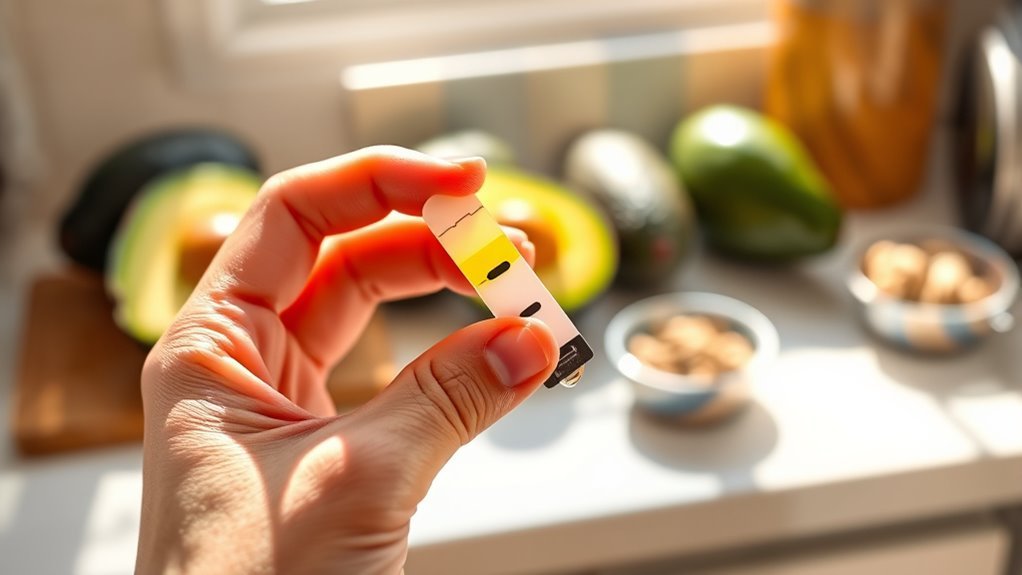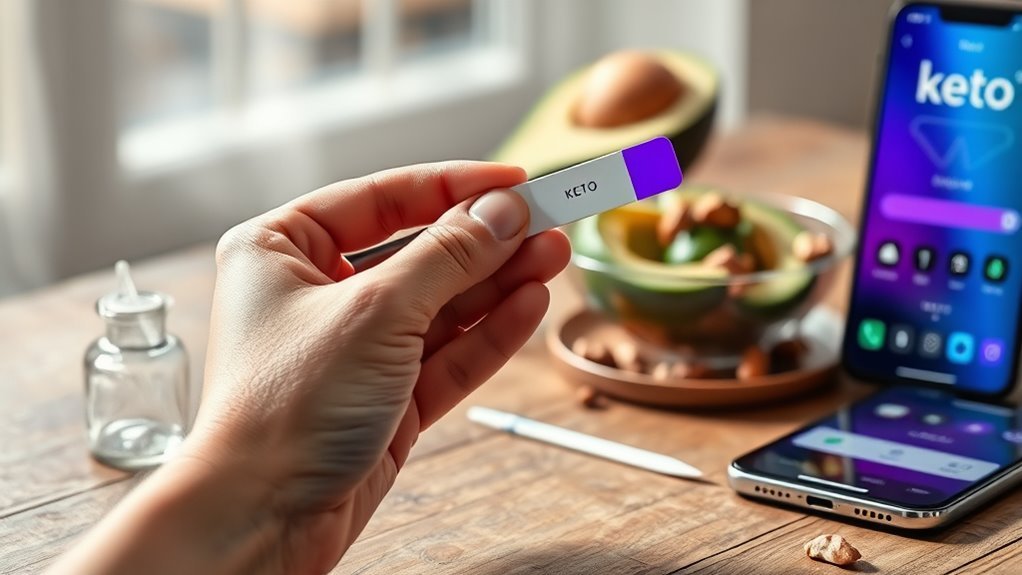Using keto strips is straightforward. First, choose the right type—urine strips are easy to use, while blood meters offer more precision. Test your ketone levels daily, especially after meals, workouts, or carb-heavy days for accurate results. Pay attention to hydration, as it influences readings. Compare your results against the color scale or numerical values on the packaging to gauge your ketone concentration. There’s much more to learn about optimizing your keto journey!
What Are Keto Strips?

Keto strips, also known as ketone test strips, are handy tools for monitoring your body’s ketone levels, which indicate whether you’re in a state of ketosis. If you’re following a keto diet, understanding your ketone production is essential for optimizing fat burning and achieving your health goals. These strips work by detecting acetoacetate, a type of ketone that your body produces when it shifts from using glucose to fat for energy. By simply dipping a strip into your urine, you can quickly assess your level of ketosis. This information empowers you to make informed dietary choices, ensuring you stay on track with your keto journey and experience the freedom that comes from effectively managing your weight and energy levels. Maintaining ketosis is crucial for achieving optimal health, so regular use of keto strips can help you fine-tune your dietary approach.
Types of Keto Strips Available

When monitoring your ketone levels, you’ll find two primary types of keto strips: urine ketone strips and blood ketone meters. Urine strips are cost-effective and easy to use, but blood meters provide more accurate and immediate readings. Understanding these options will help you choose the right method for your ketogenic journey.
Urine Ketone Strips
How can you effectively monitor your ketone levels? Urine ketone strips are a popular option for urine testing, offering a simple way to measure ketone levels in your body. These strips detect acetoacetate, a ketone body produced during fat metabolism, providing a snapshot of your ketosis state. When you dip a strip into your urine, it changes color, indicating the concentration of ketones present. It’s essential to recognize that urine measurement can vary based on hydration and time of day. While urine strips are accessible and affordable, they may not always reflect real-time blood ketone levels. For a more accurate assessment, consider combining urine testing with other methods, allowing you the freedom to track your keto journey effectively. Additionally, understanding the role of carbohydrates in your diet can help you optimize your approach to achieving and maintaining ketosis.
Blood Ketone Meters
Blood ketone meters provide a reliable and accurate way to measure your ketone levels, making them an excellent choice for those serious about tracking their ketogenic state. These devices use testing methods that analyze blood samples, offering a more precise measure compared to urine strips. With blood ketone meters, you can quickly identify if you’re in ketosis and adjust your diet accordingly. Maintaining a low carbohydrate intake is crucial for sustaining ketosis and optimizing fat burning.
| Type of Meter | Accuracy Level | Cost Range |
|---|---|---|
| Standard Meter | High | $30 – $100 |
| Advanced Meter | Very High | $100 – $300 |
| Portable Meter | Moderate | $50 – $150 |
Investing in a blood ketone meter can empower you to optimize your ketogenic journey efficiently.
How to Use Keto Strips

To effectively use keto strips, you’ll want to understand your ketosis levels and how often to test. Regular testing helps you monitor your progress and adjust your diet as needed. Accurately interpreting the results is essential for staying on track with your ketogenic goals.
Understanding Ketosis Levels
Ketosis levels are essential to understanding how well your body is adapting to a ketogenic diet. When you’re in ketosis, your body burns fat for energy, offering numerous ketosis benefits like improved mental clarity and increased fat loss. However, there are common ketosis misconceptions that can lead to confusion. For instance, some believe that being in ketosis means you’ll automatically lose weight, but individual results vary based on factors like diet quality and activity levels. By using keto strips, you can accurately measure your ketosis levels, helping you gauge your progress and adjust your diet accordingly. This awareness empowers you to embrace the ketogenic lifestyle while maximizing its benefits for your personal journey toward freedom and health. Additionally, maintaining a high fat intake is crucial for sustaining ketosis and optimizing your results.
Testing Frequency Recommendations
Understanding how often to test your ketosis levels with keto strips can greatly enhance your dietary journey. To maximize the benefits of your keto lifestyle, it’s essential to establish effective testing schedules. For beginners, testing daily during the initial phase is recommended to gauge your body’s response. Once you’ve adapted, you might reduce to a few times a week, based on your goals and lifestyle. Frequency guidelines suggest testing after meals, especially after carb-heavy days, to confirm you’re staying in ketosis. Remember, consistency is key, but flexibility can empower your journey. Adjust your testing frequency as needed, allowing you to maintain the freedom to enjoy your diet while keeping ketosis in check. Additionally, understanding what keto test strips measure can help you interpret your results more effectively.
Interpreting Results Accurately
While testing your ketosis levels with keto strips is straightforward, accurately interpreting the results requires attention to detail. When you look at your strips, focus on both reading colors and interpreting numbers for the best insights. Here are some key points to keep in mind:
- Color Scale: Each color on the strip corresponds to a different level of ketones; darker colors usually indicate higher ketone levels.
- Concentration Levels: Pay attention to the numerical values on the packaging, as they can help quantify your ketone concentration.
- Hydration Impact: Remember that dehydration can affect readings, so make certain you’re well-hydrated when testing. Achieving optimal ketosis often requires maintaining low carb intake to stay within the recommended range for effective fat burning.
Understanding Your Readings
As you track your progress on a ketogenic diet, interpreting the readings from your keto strips is essential for guaranteeing you’re in the desired metabolic state. The strips measure the presence of ketones in your urine, reflecting your ketone metabolism. Higher readings indicate that your body is efficiently burning fat for fuel, while lower levels suggest you might need to adjust your diet to maintain ketosis. For reading accuracy, verify you’re using the strips correctly—check expiration dates and follow the instructions closely. Remember, individual responses to a ketogenic diet can vary, so use these readings as a guide rather than an absolute measure of success. Understanding your readings empowers you to make informed decisions that align with your health goals. To maintain ketosis, it’s crucial to keep your carb intake within the range of 20 to 50 grams per day to ensure effective fat burning.
Factors Affecting Ketone Levels
Several factors can influence your ketone levels, impacting how effectively your body enters and maintains ketosis. Understanding these elements can help you optimize your ketogenic journey. Here are three key factors:
- Dietary factors: The types and amounts of fats, proteins, and carbohydrates you consume greatly affect ketone production. A high-fat, low-carb diet is essential for promoting ketosis.
- Hydration levels: Proper hydration supports metabolic processes, including fat oxidation. Dehydration can hinder your body’s ability to produce and utilize ketones.
- Exercise intensity: Physical activity can influence ketone levels, as intense workouts may increase ketone production while also utilizing them for energy. Additionally, staying hydrated is crucial for maintaining optimal ketone levels during your workouts.
Tips for Accurate Testing
To guarantee accurate testing of your ketone levels, it’s crucial to follow specific guidelines that minimize variability. Here are some accuracy tips: First, make sure you’re using fresh, unexpired keto strips, as old strips can yield unreliable results. Second, store your strips in a cool, dry place, away from direct sunlight. When testing, follow the manufacturer’s instructions precisely to avoid discrepancies in results. It’s also recommended to test at the same time each day for consistency. Additionally, consider using multiple testing techniques, such as urine and blood tests, to cross-reference your ketone levels. By adhering to these practices, you’ll enhance the reliability of your measurements and gain better insight into your ketogenic journey. Maintaining a carb limit of 20-50 grams per day is essential for staying in ketosis and ensuring accurate readings from your tests.
When to Test for Optimal Results
Knowing when to test your ketone levels can considerably impact the accuracy of your results. Establishing a consistent testing schedule with best timing is key to tracking your progress effectively. Here are three ideal times to test:
- Morning: Test after waking up to assess your overnight ketosis.
- Post-Workout: Measure levels after exercise when your body is in a fat-burning state.
- Before Meals: Check your ketones before eating to understand your body’s response to food. Additionally, testing at these times can help identify hidden carbs that may be affecting your ketosis levels.
Frequently Asked Questions
Can Keto Strips Be Reused for Multiple Tests?
Keto strips can’t be reused for multiple tests; their lifespan is limited to one use. While you might think reusing them could save money, it actually compromises accuracy. Each strip’s chemical reaction is designed for a single test, so testing frequency should rely on fresh strips for reliable results. If you’re serious about monitoring your ketone levels, investing in new strips will give you the freedom to track your progress effectively.
Are There Any Side Effects of Using Keto Strips?
Using keto strips is generally safe, with minimal side effects. However, some users may experience skin irritation from prolonged contact with the test strip or an inaccurate reading if not used correctly. It’s essential to follow the instructions closely to guarantee testing accuracy. While you’re tracking your ketosis, remember that individual reactions can vary. If you notice any adverse effects, it’s wise to consult a healthcare professional for personalized advice.
How Often Should I Test My Ketone Levels?
You should test your ketone levels at least once a day, preferably in the morning for ideal timing. This testing frequency helps you track your progress effectively and adjust your diet as needed. If you’re more active or making significant dietary changes, consider testing more frequently. Remember, consistency is key to understanding how your body responds to the keto diet, allowing you the freedom to make informed choices about your nutrition.
Can I Use Expired Keto Strips?
You shouldn’t use expired keto strips. Their accuracy can greatly decline past the expiration date, leading to unreliable results. Testing reliability is essential for managing your ketone levels effectively. Using expired strips might give you a false sense of security or mislead you about your diet’s effectiveness. For the best results, always check the expiration date and invest in fresh strips to guarantee you’re accurately tracking your ketosis journey.
Do Diet Variations Affect Keto Strip Accuracy?
Yes, diet variations can impact keto strip accuracy. You might think that all diets are created equal, but the truth is, what you eat can skew your results. For instance, a high-carb meal can lead to false negatives, while a consistent low-carb intake can enhance testing accuracy. So, if you’re chasing that keto lifestyle, keep your meals steady to get the best reading from those strips. Your diet truly dictates your testing outcomes!


